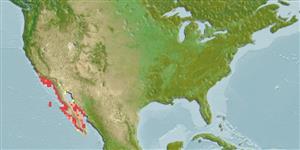Environment: milieu / climate zone / depth range / distribution range
Ökologie
seewasser; brackwasser; tiefenbereich 0 - 50 m (Ref. 189). Subtropical; 36°N - 20°N, 121°W - 110°W (Ref. 189)
Eastern Central Pacific: Morro Bay, California (Ref. 2850) to Magdalena Bay, Baja California, Mexico.
Size / Gewicht / Alter
Maturity: Lm ? range ? - ? cm
Max length : 13.3 cm SL Männchen/unbestimmt; (Ref. 9298); common length : 10.0 cm SL Männchen/unbestimmt; (Ref. 9298); max. veröff. Alter: 6 Jahre (Ref. 72482)
Rückenflossenstacheln (insgesamt): 0; Afterflossenstacheln 0; Afterflossenweichstrahlen: 27 - 34. Moderately deep. Snout pointed, about 1/2 to 3/4 eye diameter; maxilla moderate, tip rather blunt, not reaching to hind border of pre-operculum; pseudobranch short, covered by skin; gill cover canals of panamensis-type. Anal fin origin a little before midpoint of dorsal fin base. A bright silver stripe along flank, often as wide as eye, not fading on preservation.
A schooling species most commonly found in bays and inlets (the fourth most abundant fish taken by various gear in Newport Bay, California; its eggs are the most abundant of 7 species sampled, especially in May). The ovarian eggs are spherical. Eggs and larvae are planktonic (Ref. 35602). Feeds on plankton (Ref. 8593). Basically filter-feeders, but at times have been observed feeding by selection (Ref. 4930). Normally used as bait (Ref. 9298).
Life cycle and mating behavior
Geschlechtsreife | Fortpflanzung | Ablaichen | Eier | Fecundity | Larven
Oviparous (Ref. 35602). Spawn in school (Ref. 205).
Whitehead, P.J.P., G.J. Nelson and T. Wongratana, 1988. FAO Species Catalogue. Vol. 7. Clupeoid fishes of the world (Suborder Clupeoidei). An annotated and illustrated catalogue of the herrings, sardines, pilchards, sprats, shads, anchovies and wolf-herrings. FAO Fish. Synop. 125(7/2):305-579. Rome: FAO. (Ref. 189)
IUCN Rote Liste Status (Ref. 130435)
Bedrohung für Menschen
Harmless
Nutzung durch Menschen
Köder: usually
Mehr Information
ReferenzenAquakulturAquakultur ProfilZuchtlinienGenetikElectrophoresesVererbbarkeitKrankheitenVerarbeitungNutrientsMass conversion
Tools
Zusatzinformationen
Download XML
Internet Quellen
Estimates based on models
Preferred temperature (Ref.
123201): 13.2 - 21.6, mean 17.7 °C (based on 12 cells).
Phylogenetic diversity index (Ref.
82804): PD
50 = 0.5000 [Uniqueness, from 0.5 = low to 2.0 = high].
Bayesian length-weight: a=0.00513 (0.00232 - 0.01135), b=3.14 (2.96 - 3.32), in cm total length, based on LWR estimates for this Genus-body shape (Ref.
93245).
Trophic level (Ref.
69278): 3.4 ±0.45 se; based on food items.
Widerstandsfähigkeit (Ref.
120179): hoch, Verdopplung der Population dauert weniger als 15 Monate. (Preliminary K or Fecundity.).
Fishing Vulnerability (Ref.
59153): Low vulnerability (10 of 100).
Nutrients (Ref.
124155): Calcium = 192 [123, 439] mg/100g; Iron = 1.91 [1.08, 3.46] mg/100g; Protein = 17.9 [15.6, 20.6] %; Omega3 = 0.499 [0.277, 0.934] g/100g; Selenium = 17.2 [8.1, 37.9] μg/100g; VitaminA = 20.4 [6.6, 54.1] μg/100g; Zinc = 1.36 [0.94, 2.07] mg/100g (wet weight);
